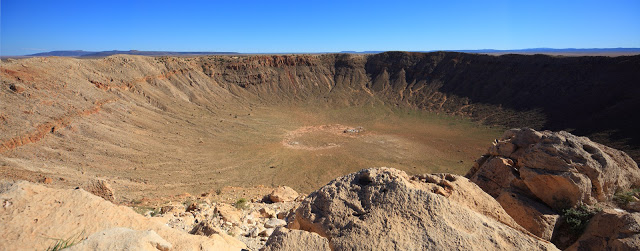
The geologists Prof. Dr. Stefan Hergarten and Prof. Dr. Thomas Kenkmann from the Institute of Earth and Environmental Sciences of the University of Freiburg have published the world’s first study on the question of how many meteorite craters there should be on the Earth’s surface. A total of 188 have been confirmed so far, and 340 are still awaiting discovery according to the results of a probability calculation presented by the two researchers in the journal Earth and Planetary Science Letters.
Meteorite impacts have shaped the development of the Earth and life repeatedly in the past. The extinction of the dinosaurs, for instance, is thought to have been brought on by a mega-collision at the end of the Cretaceous period. But how many traces of large and small impacts have survived the test of time? In comparison to the more than 300,000 impact craters on Mars, the mere 188 confirmed craters on Earth seem almost negligible. Moreover, 60 of them are buried under sediments. Advances in remote sensing have not led to the expected boom in crater discoveries: An average of only one to two meteorite craters are discovered per year, most of them already heavily eroded.
The probability of a meteorite impact on Earth is not fundamentally different than on Mars. However, the Earth’s surface changes much more quickly. As a result, the craters remain visible for a much shorter period of time, meaning that many less of them are detectible today. “The main challenge of the study was to estimate the long-term effect of erosion, which causes craters to disappear over time,” says Hergarten. The life span of a crater depends on the rate of erosion and its size. Large craters can achieve a life span of several 100 million years, depending on the region in which they are located. On the other hand, large impacts are much rarer than small impacts. The solution was to compare the amount of confirmed craters of different sizes, calculate the expected frequency of the impacts on the basis of the known probabilities, and combine this information to infer the rates of erosion.
“A surprising, initially sobering finding we made was that there are not many craters of above six kilometers in diameter left to discover on the Earth’s surface,” reports Hergarten. In the case of smaller craters, on the other hand, the scientists found the current list to be far from complete: Around 90 craters with a diameter of one to six kilometers and a further 250 with a diameter of 250 to 1000 meters are still awaiting discovery. While there are undoubtedly still a number undiscovered large craters buried deep under sediments, they are much more difficult to detect and confirm.
Reference:
S. Hergarten, T. Kenkmann. The number of impact craters on Earth: Any room for further discoveries? Earth and Planetary Science Letters, 2015; 425: 187 DOI: 10.1016/j.epsl.2015.06.009
Note: The above post is reprinted from materials provided by Albert-Ludwigs-Universität Freiburg.










